UPR, LCI and LCIA
Details on Unit Process (UPR), Cumulative Life Cycle Inventory (LCI), and Life Cycle Impact Assessment (LCIA) are covered in this article.
Feb, 14th 2024
Cumulative Life Cycle Inventory (LCI)
Life Cycle Impact Assessment (LCIA)
Unit Process (UPR)
The basic building blocks of the database are individual processes of human activities and their exchanges with the environment (elementary exchanges) and with the Technosphere (intermediate exchanges).
 In the ecoinvent database, these are called unit processes (UPR), also known as gate-to-gate inventories. These processes are neither vertically aggregated with subsequent processes in a supply chain nor horizontally aggregated with processes delivering the same intermediate outputs. Hence, every process that occurs along a supply chain forms its own unit, for which a separate life cycle inventory is available.
In the ecoinvent database, these are called unit processes (UPR), also known as gate-to-gate inventories. These processes are neither vertically aggregated with subsequent processes in a supply chain nor horizontally aggregated with processes delivering the same intermediate outputs. Hence, every process that occurs along a supply chain forms its own unit, for which a separate life cycle inventory is available.
Nevertheless, activities are most often reported at the national level, averaging information from different producers using the same technology in the same country to deliver meaningful background data to the user. Similarly, UPR would rarely represent the production of products that are exclusively used as intermediate products for a subsequent process.
Undefined and Linked UPRs
UPRs are available in undefined and linked forms.
Undefined UPRs show the data as compiled by the data provider. Undefined UPRs are unlinked (no suppliers determined) multi-product (multi-output) activities. This is the starting point on which system model-specific modeling choices are applied.
In system models, the supply chain of the activity is determined by linking the exchanges to their suppliers. Subdivision and allocation are applied to produce linked single-product UPRs (see system models section).
Note: in ecoQuery, you can access both forms of UPR. Linked UPRs are available simply by consulting the “Exchanges” section of a dataset. The Undefined UPRs are available via the dropdown menu “System model”. These types of information are available only to licensees. As a guest, you can at least consult the general documentation.
Cumulative Life Cycle Inventory (LCI)
In order to generate value chains and calculate environmental impacts of products, the individual UPRs are linked into supply chains (systems).
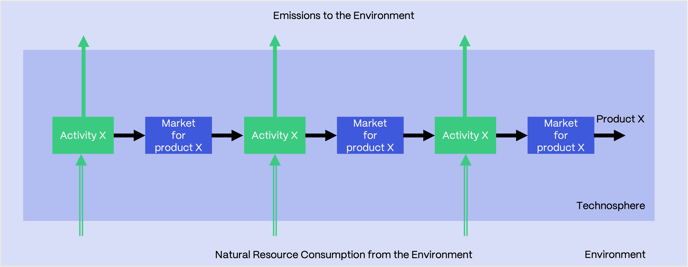
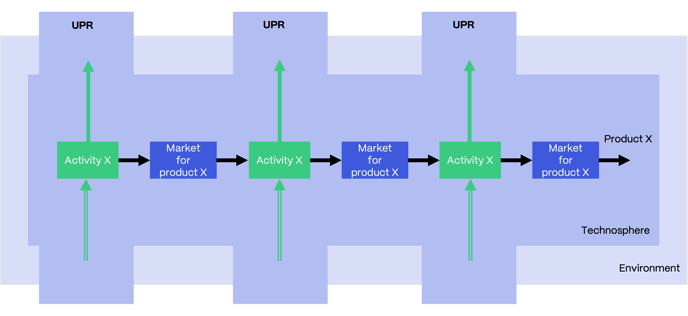
Where natural resource consumption or emissions of the same type occur at different stages of a supply chain, their amounts are aggregated. This results in a comprehensive list of the natural resources taken from and the emissions released to the environment associated with the life cycle of the final product, from cradle to the factory gate. Where end-of-life treatment or disposal processes of wastes are required, the life cycle ranges from cradle to grave.
The aggregated list of elementary exchanges associated with the life cycle of a product is called the cumulative life cycle inventory (LCI).
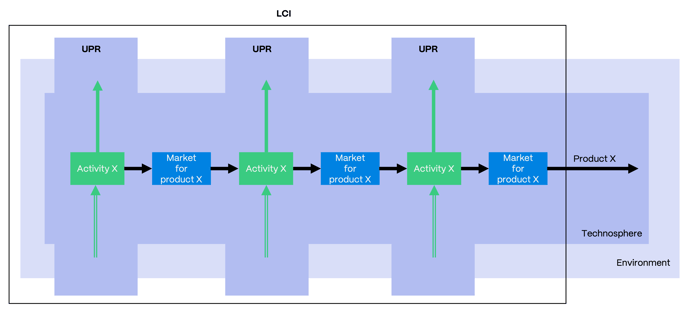
Life Cycle Impact Assessment (LCIA)
The cumulative list of elementary exchanges does not yet provide information about the environmental impact caused by these natural resource inputs and emissions to the environment.
This is where Life Cycle Impact Assessment (LCIA) methods come into play. They quantify what and how much damage or benefit is associated with an elementary exchange in the form of so-called characterisation factors (CFs). For example, methane (CH4) is a greenhouse gas that has an impact on climate change measured as global warming potential in kg CO2-equivalent (CO2-eq). The impact assessment considers that the effects of methane in the atmosphere are twenty-nine times higher as those of CO2 when it comes to global warming. Therefore, the emission of 1kg of CH4 is multiplied by the CF of 29, resulting in a global warming potential of 29kg CO2-equivalents.
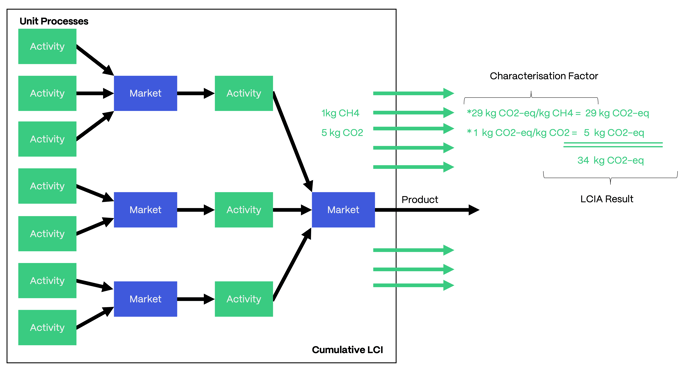
Elementary exchanges may contribute to one or more impact categories, such as “climate change,” “human toxicity,” “land use,” or “water use.” Once all exchanges have been matched and multiplied with all their CFs, the result is the LCIA score of a product.
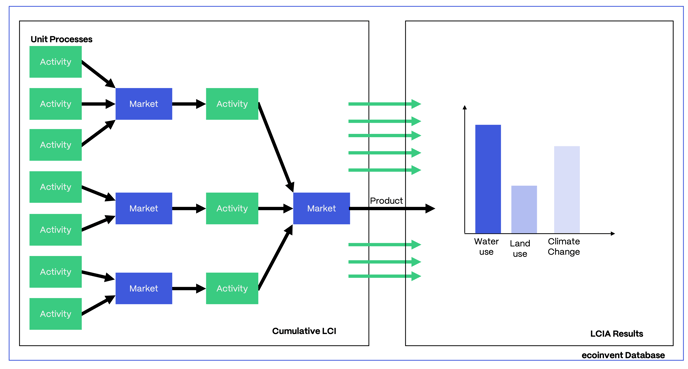
As a background database, the focus of ecoinvent is on the compilation of the basic building blocks, UPRs, representing the individual unit processes of human activities and their exchanges with the environment, and the combination of these UPRs in supply chains to form LCIs. Nevertheless, the database also contains data on LCIA scores. These are calculated by applying already developed LCIA methods, such as the global warming potential of the Intergovernmental Panel on Climate Change (IPCC).
Download the LCIA implementation file in the file section of ecoQuery to see what LCIA methods are available in the ecoinvent database and which CFs apply.